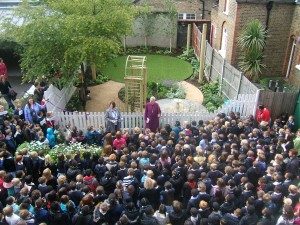Say NO To Plastic Grass and Plants
I fully support a new campaign launched this month by the Society of Garden Designers (SGD) in conjunction with the Royal Horticultural Society (RHS) and the Landscape Institute (LI), that highlights the extreme environmental damage and decline to wildlife caused by artificial grass and plants.
The ‘Say NO to Plastic Grass and Plants’ campaign aims to encourage homeowners, gardeners, garden designers and landscapers to opt for natural solutions in gardens, to help cut down the pollution and ecological destruction caused by plastic grass and to create more habitats for birds, bees and other wildlife.
The UK now ranks as one of the most nature-depleted countries in Europe. One of the key reasons for this decline is the loss of natural habitats and ‘green corridors’ in our towns and cities, of which gardens form a major part.
I highlighted this problem five years ago in a blog post on this website back in 2018. Sadly, since then there has been huge growth in the use of plastic lawns, with devastating effects on both the environment and biodiversity.
Artificial grass destroys soil ecosystems by removing topsoil and covering the ground in plastic, eliminating a crucial habitat for earthworms, fungi and a whole host of other soil organisms. This in turn removes all sources of food and habitat for insects, birds and other animals.
Plastic grass is manufactured from fossil fuel-based plastics, which results in increased carbon dioxide emissions, a greenhouse gas that contributes to global warming. By contrast, natural lawns and plants absorb CO2 from the atmosphere.
When heated by the sun, natural lawns are cooled through evaporation. However, plastic lawns absorb the sun’s heat, becoming hot under foot and contributing to ‘urban heat islands.’
Artificial grass absorbs less water than natural lawns, causing more run-off and potentially flooding. Furthermore, as the plastic used to make artificial grass gradually deteriorates, microplastics are released into the environment and watercourses, polluting our rivers and seas.
Despite dubious claims made by some manufacturers of artificial grass, it is not bio-degradable, cannot be recycled, does not last forever and is definitely not maintenance-free, requiring regular cleaning and even weeding!
There are plenty of natural and sustainable options that benefit both people and the environment. For instance, a traditional mown lawn or a low-mow lawn that allows flowering plants to flourish between cuts. Other options include chamomile lawns or clover lawns in sunnier areas or blue star creeper ground cover in shadier areas. Or why not try a wildflower meadow to encourage even greater biodiversity.
Even a bark chip mulch under and around children’s climbing frames and trampolines is a better option than artificial grass. Being a natural organic material, it will gradually break down releasing nutrients back into the soil and can easily be topped up if required.
In light of all the detrimental effects of artificial grass, there really is no excuse to use it. I will not be specifying artificial grass or plants in any of my garden designs.


